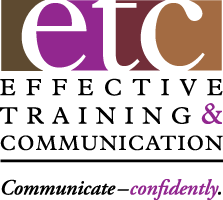Let’s assume you’ve just created some Best-in-Class slides – the right number with the right content and the right design – to support your message and add value to the audience experience. Great … now it’s time for you to Use Them with Sizzle!
Here are 10 more techniques to add to your Workplace Presenter’s Tool Kit that deal with what you should do and say when using slides. Conventional wisdom dictates that how you use them may have more impact on your audience and results than what is on them. That’s where the sizzle comes in.
- Make sure the room lighting works for both your slides and the audience. A dimly lit room will help them fall asleep faster than your content or delivery. If possible, only turn off the lights closest to the screen that would wash out the image. If the room isn’t wired that way, try removing the bulbs from those fixtures closest to the screen.
- Consider not having a title slide on at the beginning of the presentation. The visual impact of a blank screen focuses attention on you during your all-important introduction. As you transition into your first content point, then bring on the slides. Plus, no title slide can minimize the audience expectation that this will be another dose of ‘Death by PowerPoint’ from the time they walk in the room.
- ‘Visual Silence’. An effectively visualized presentation doesn’t need to be a non-stop slide show with attached narrator. You can turn the screen black or transition to a blank background slide between sections that are slide-supported.
- Remember to keep the slides in synch with your comments. Don’t bring them on too early or leave them up too long. If you’re finished with one slide, but not ready for the next, use one of the above ‘visual silence’ techniques. .
- Never talk to the screen – only talk to the faces in the room. If you need to look at the screen to remind you what to say next, fine. Just do it in silence. Better yet, have your laptop monitor positioned so that it’s in your direct line of sight with the audience. If you can’t easily read the copy from where you stand, they probably can’t either. Or, use screen prints as your notes if you need them.
- Make sure the sight lines work. Position yourself relative to the audience and screen so you don’t block anyone’s view. And don’t walk in front of the screen – ever. That’s really distracting and annoying. If you must move around, do so in the narrow space available that doesn’t block anyone’s view.
- Set up each slide for the audience as you transition to it by indicating the content. Say something like ‘This graph shows our sales results over the last three years.’ Or ‘Now, let’s move from disadvantages of the plan to its advantages’ or ‘Here’s another example of the impact of proper maintenance on equipment performance’.
- Give the audience a few seconds of silence to absorb the slide content, either before your transitional phrase or after it. They can’t read and listen to you at the same time.
- If someone else is changing the slides for you, rehearse enough with them so you can avoid the increasingly irritating ‘Next slide please’. More subtle transitions work better and are more audience-friendly, like ‘The next slide will highlight … ‘ or ‘Let’s move on to our third example of …’
- If you’re providing a hard copy or an electronic version of the slides or if the content is otherwise in your handout, let the audience know that up front so they will feel less need to take notes.
Your Presenter’s Tool Kit should be very full now, so start using these Sizzle Strategies immediately to maximize the audience-centric value of your slides and make sure no one ever accuses you of inflicting ‘Death by PowerPoint’ on them.
